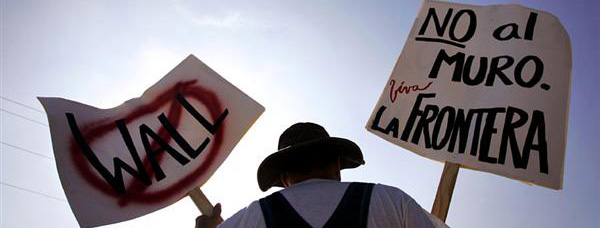
|  |  |  Editorials | Issues | September 2008 Editorials | Issues | September 2008  
US-Mexico Border Fence Creates Divide in Many Ways
 Traci Carl - The Associated Press Traci Carl - The Associated Press
go to original


| | (Ben Fredman/Corbis) | | |
Tijuana, Mexico - There is a moment each evening, as the sun melts into the Pacific, when Colonia Libertad is at peace.

The dimming light blurs the hilltop slum's rough edges, camouflaging piles of trash in long shadows and making it difficult to tell that some of the tightly packed homes clinging to vertical canyon sides are made of old packing crates and cast-off plastic tarps.

The stadium lighting that towers over the corrugated metal wall marking the U.S.-Mexico border is dark, permitting residents a bird's eye view of Tijuana, where lights are blinking, blanketing hills that lead toward the ocean.

There are no helicopters reverberating overhead, no drone of all-terrain vehicles. Even the bony guard dogs chained outside their homes respect the silence. Fathers stroll lazily behind children who steer beat-up tricycles along the rutted dirt paths that serve as streets.

For a moment, residents are reminded of what it was like before the wall, when children ducked under a barbed wire fence to play soccer in U.S. territory and returned home for dinner. When smuggling meant giving directions to migrants who simply outran border agents and melted into the crowds of tourists.

But it is only a moment.

The floodlights click on, bathing the neighborhood in a blinding light. The helicopters return, clattering past. And the smugglers arrive with their ladders and blow torches and groups of people desperate to escape a fate similar to the one Colonia Libertad residents long ago accepted.

Building borders

As the U.S. government battles environmentalists and residents to build hundreds more miles of fencing along the 2,000-mile U.S.-Mexico border, both sides would be well served to take a long look at Colonia Libertad - Freedom Neighborhood.

In the early 1990s, Colonia Libertad became one of the first places to coexist with the recycled, corrugated-iron barrier that has become a symbol of the conflicted relationship between a first-world superpower and the developing nation that lives in its shadow.

The fence didn't stop the migrants. It didn't stop the drugs. It merely pared down the hopeful crowds that used to flood San Diego hillsides, diverted the drugs underground and into the mountains, and helped create a ruthless smuggling industry dedicated to beating the U.S. Border Patrol at its own game.

But that's not to say the sections of fence that have been built haven't been successful. The barriers, combined with high-tech security measures such as surveillance cameras and ground sensors, have made getting into the U.S. extremely difficult. And as security has increased in recent years, the number of people trying to cross has fallen dramatically.

The downside, residents on both sides say, is that the border has become a violent battleground, shattering a shared American and Mexican history that is blind to things such as fences and borders.

On the fence

When the first stretch of wall went up it was made of material recycled from landing strips left over from Vietnam.

The fence cut off the view of the United States But little else changed in Colonia Libertad. Smugglers cut holes in the fence and drove their vans through. Migrants scrambled over the wall, using the corrugated ridges like the steps of a ladder.

Americans saw the fence as a necessity because millions of undocumented workers and tons of illegal drugs were streaming into their cities.

But it had consequences they never intended: Seasonal workers unable to easily go back and forth built permanent lives north of the border. Migrants were pushed into the searing desert of Arizona, and more than 1,600 have died, often of thirst and exposure.

In Tijuana, the United States kept increasing security, using the area to test new anti-smuggling methods and expanding the ones that worked. It added a second layer of fencing at some points, redesigning each barrier to make it more difficult to overcome.

Drug smugglers got more sophisticated. They have built more than two dozen tunnels under the border since 1994. One opened into a warehouse steps from the border, and drug dealers posing as businessmen quietly shipped their wares across the U.S. until agents shut them down.

Other drug runners took to the mountains, using blowtorches to cut large doors in the fence and then taking four-wheel-drive vehicles across the rugged terrain.

Smugglers responded by charging migrants more money and becoming more violent. Sometimes they wanted to hurt border agents, but mostly they were trying to create diversions while they moved people or drugs across at another point.

Since last October, there have been 340 assaults on Border Patrol agents patrolling the California border. The Border Patrol said it doesn't know whether any agents were injured in the attacks.

The response, however, has taken a toll. In 2005, an 18-year-old Mexican boy was fatally shot by the Border Patrol. In August, a Mexican man was shot and wounded by an agent trying to disperse a group of rock throwers at a dry, concrete-lined gulley near Colonia Libertad.

And the building continues. |

 |
|  |



